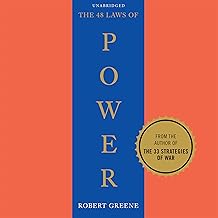
How to Read Robert Greene's Books on Power books
How to Read Robert Greene's Books on Power
Estimated Reading Time: 10-12 minutes
Introduction
Robert Greene, an American author known for his exploration of power dynamics, strategy, and human behavior, has carved a unique niche in the realm of self-help and philosophy. Born in 1966, Greene's background in classical studies and his experiences in various professions have informed his writing style, which combines historical anecdotes with psychological insights. His works, particularly "The 48 Laws of Power," "The Art of Seduction," and "The 33 Strategies of War," delve into the complexities of power and influence, offering readers a toolkit for navigating social and professional landscapes.
Greene's perspective on power is both pragmatic and often controversial, challenging conventional morality and encouraging readers to think strategically about their interactions. His books are not merely theoretical; they are grounded in historical events and figures, providing a rich tapestry of examples that illustrate the principles he advocates. In a world where understanding power dynamics is crucial for success, Greene’s insights remain as relevant today as they were when his books first hit the shelves.
Why Robert Greene's Perspective Matters
What sets Robert Greene apart from other thinkers is his unapologetic approach to power. While many authors advocate for ethical leadership and collaboration, Greene emphasizes the often harsh realities of human nature and the necessity of strategic thinking in achieving one's goals. His works encourage readers to confront uncomfortable truths about ambition, manipulation, and the pursuit of success.
Greene's unique insights stem from his extensive research into historical figures, drawing lessons from their successes and failures. This historical context enriches his arguments, making them not just theoretical musings but practical strategies that can be applied in modern life. His perspective has influenced a diverse audience, from business leaders to artists, all seeking to understand the underlying currents of power in their environments.
Overview of Recommended Books
The 48 Laws of Power
"The 48 Laws of Power" is perhaps Greene's most famous work, providing a comprehensive guide to understanding and wielding power. The book is structured around 48 distinct laws, each illustrated with historical examples and anecdotes that bring the principles to life.
Main Themes and Arguments: Greene's central argument is that power is an inherent aspect of human relationships. He outlines strategies for gaining, maintaining, and protecting power, often drawing on historical figures like Machiavelli, Sun Tzu, and Bismarck to illustrate his points. The laws are not prescriptive in a moral sense; rather, they reflect the realities of human behavior and societal structures.
Historical Context and Significance: Published in 1998, "The 48 Laws of Power" emerged during a time when self-help literature was gaining popularity. Greene's work stood out for its candid exploration of manipulation and strategy, resonating with readers who felt disillusioned by traditional notions of leadership.
Key Insights and Takeaways:
- Law 1: Never Outshine the Master - This law emphasizes the importance of making those above you feel superior, which can secure your position and influence.
- Law 15: Crush Your Enemy Totally - Greene argues that leaving no room for retaliation is essential for maintaining power.
- Law 33: Discover Each Man's Thumbscrew - Understanding others' weaknesses can be a powerful tool in negotiations and relationships.
Why Read This Book: "The 48 Laws of Power" is essential for anyone looking to navigate complex social dynamics, whether in personal relationships or professional settings. Its unique contribution lies in its unflinching examination of power, making it a must-read for those seeking to understand the darker aspects of human interaction.
The Art of Seduction
In "The Art of Seduction," Greene explores the intricate dance of attraction and manipulation through the lens of seduction. The book is divided into two main parts: the first outlines the different types of seducers, while the second provides a guide to the seductive process.
Main Themes and Arguments: Greene posits that seduction is a form of power, one that can be wielded to influence and control others. He categorizes seducers into archetypes, such as the Siren, the Rake, and the Ideal Lover, each embodying different strategies for attraction.
Historical Context and Significance: Released in 2001, this book reflects a growing fascination with interpersonal dynamics and the psychology of attraction. Greene's approach is both provocative and enlightening, challenging readers to reconsider their own behaviors and motivations in relationships.
Key Insights and Takeaways:
- Create an Air of Mystery - Seduction thrives on intrigue; the less predictable you are, the more captivating you become.
- Use the Power of Words - Language can be a potent tool in seduction; persuasive communication can draw others in.
- Lead the Target to the Desired Conclusion - Subtly guiding someone to your desired outcome can be more effective than direct persuasion.
Why Read This Book: "The Art of Seduction" is invaluable for those interested in understanding the complexities of attraction and influence. Its unique contribution lies in framing seduction as a strategic endeavor, making it relevant for both romantic and professional contexts.
The 33 Strategies of War
In "The 33 Strategies of War," Greene draws parallels between military strategy and everyday life, offering readers a tactical guide to overcoming obstacles and achieving their goals. The book is structured around 33 strategies that can be applied in various contexts, from personal conflicts to corporate battles.
Main Themes and Arguments: Greene argues that life is a battlefield, and understanding the principles of warfare can provide a competitive edge. Each strategy is illustrated with historical examples, emphasizing the importance of adaptability and foresight.
Historical Context and Significance: Published in 2006, this work reflects a growing interest in strategy and competition in business and personal development. Greene's military analogies resonate with readers looking for practical applications of strategic thinking.
Key Insights and Takeaways:
- The Guerilla-War-of-the-Mind - This strategy emphasizes the importance of unpredictability and psychological tactics in overcoming larger opponents.
- Know Your Enemy - Understanding your adversaries' strengths and weaknesses is crucial for formulating effective strategies.
- Create a Sense of Urgency - Instilling a sense of urgency can mobilize action and create momentum in achieving goals.
Why Read This Book: "The 33 Strategies of War" is essential for readers seeking to enhance their strategic thinking and problem-solving skills. Its unique contribution lies in its application of military principles to everyday challenges, making it relevant for anyone facing competition or conflict.
How These Books Complement Each Other
Greene's three major works on power are interconnected, each building upon the concepts introduced in the others. "The 48 Laws of Power" lays the foundation for understanding power dynamics, while "The Art of Seduction" explores the nuances of interpersonal influence. "The 33 Strategies of War" provides a broader context for applying these principles in competitive scenarios.
Together, these books offer a comprehensive understanding of power, from the individual to the strategic level. Readers who engage with all three will gain a multifaceted perspective on how to navigate the complexities of human relationships and societal structures.
Who Would Benefit from Reading These Books
The ideal readers for Greene's works include:
- Students and Academics - Those studying psychology, sociology, or political science can gain valuable insights into human behavior and power dynamics.
- General Readers Interested in Power - Anyone curious about the mechanics of influence and control will find Greene's works enlightening.
- Professionals Seeking Practical Wisdom - Business leaders and entrepreneurs can apply Greene's strategies to enhance their leadership and negotiation skills.
- Anyone Looking for Personal Growth - Individuals seeking to improve their interpersonal skills and self-awareness will benefit from Greene's candid explorations of human nature.
Recommended Reading Order
- Start with: The 48 Laws of Power - This foundational text introduces key concepts and sets the stage for understanding the dynamics of power.
- Continue with: The Art of Seduction - Building on the principles of power, this book delves into the subtleties of attraction and influence.
- Advanced reading: The 33 Strategies of War - This book expands the discussion to strategic thinking, offering practical applications for overcoming challenges.
Tips for Getting the Most Out of Each Book:
- Take notes on key insights and how they relate to your own experiences.
- Reflect on historical examples and consider their relevance to contemporary situations.
- Engage with the material critically; not all strategies may align with your values, so discern which resonate with you.
Conclusion
Robert Greene's contributions to the discourse on power are both profound and practical. His works challenge readers to confront the complexities of human behavior and the realities of ambition. By exploring "The 48 Laws of Power," "The Art of Seduction," and "The 33 Strategies of War," readers can equip themselves with the knowledge and strategies necessary for navigating the intricate web of social dynamics.
As you delve into these texts, remember that the insights offered are not just about manipulation but about understanding the world around you. Embrace the lessons, reflect on your own experiences, and consider how you can apply these principles to foster personal growth and success. The timeless relevance of Greene's ideas invites you to explore the depths of power and influence in your own life.
Tags: #RobertGreene #PowerBooks #Philosophy #ReadingGuide #ClassicLiterature #Wisdom
Featured Books

The 48 Laws of Power
by Robert Greene
Published: 1998
Amoral, cunning, ruthless, and instructive, this multi-million-copy New York Times bestseller is the definitive manual for anyone interested in gaining, observing, or defending against ultimate control – from the author of The Laws of Human Nature. This is the only authorized paperback edition in the US. In the book that People magazine proclaimed “beguiling” and “fascinating,” Robert Greene and Joost Elffers have distilled three thousand years of the history of power into 48 essential laws by drawing from the philosophies of Machiavelli, Sun Tzu, and Carl Von Clausewitz and also from the lives of figures ranging from Henry Kissinger to P.T. Barnum. Some laws teach the need for prudence (“Law 1: Never Outshine the Master”), others teach the value of confidence (“Law 28: Enter Action with Boldness”), and many recommend absolute self-preservation (“Law 15: Crush Your Enemy Totally”). Every law, though, has one thing in common: an interest in total domination. In a bold and arresting two-color package, The 48 Laws of Power is ideal whether your aim is conquest, self-defense, or simply to understand the rules of the game. Read more

The Art of Seduction
by Robert Greene
Published: 2001
From the author of the multi-million copy bestseller The 48 Laws of Power and The Laws of Human Nature, a mesmerizing handbook on seduction: the most subtle and effective form of power. This is the only authorized paperback edition in the US. When raised to the level of art, seduction, an indirect and subtle form of power, has toppled empires, won elections and enslaved great minds. Immerse yourself in the twenty-four maneuvers and strategies of the seductive process, the ritual by which a seducer gains mastery over his target. Understand how to "Poeticize Your Presence," “Keep them in Suspense – What Comes Next” and “Master the Art of the Bold Move”. Every bit as essential as The 48 Laws of Power, The Art of Seduction is an indispensable primer of persuasion that reveals one of history's greatest weapons and the ultimate form of power. Read more

The 33 Strategies of War
by Robert Greene
Published: 2001
Brilliant distillations of the strategies of war—and the subtle social game of everyday life—by the bestselling author of The 48 Laws of Power and The Laws of Human Nature. This is the only authorized paperback edition in the US. Robert Greene’s groundbreaking guides, The 48 Laws of Power, The Art of Seduction, and Mastery, espouse profound, timeless lessons from the events of history to help readers vanquish an enemy, ensnare an unsuspecting victim, or become the greatest in your field. In The 33 Strategies of War, Greene has crafted an important addition to this ruthless and unique series.Spanning world civilizations, synthesizing dozens of political, philosophical, and religious texts and thousands of years of violent conflict, The 33 Strategies of War is the I-Ching of conflict, the contemporary companion to Sun Tzu’s The Art of War.Abundantly illustrated with examples from history, including the folly and genius of everyone from Napoleon to Margaret Thatcher, Shaka the Zulu to Lord Nelson, Hannibal to Ulysses S. Grant, as well as movie moguls, Samurai swordsmen, and diplomats, each of the thirty-three chapters outlines a strategy that will help you win life’s wars. Learn the offensive strategies that require you to maintain the initiative and negotiate from a position of strength, or the defensive strategies designed to help you respond to dangerous situations and avoid unwinnable wars. The great warriors of battlefields and drawing rooms alike demonstrate prudence, agility, balance, and calm, and a keen understanding that the rational, resourceful, and intuitive always defeat the panicked, the uncreative, and the stupid. An indispensable book, The 33 Strategies of War provides all the psychological ammunition you need to overcome patterns of failure and forever gain the upper hand. Read more